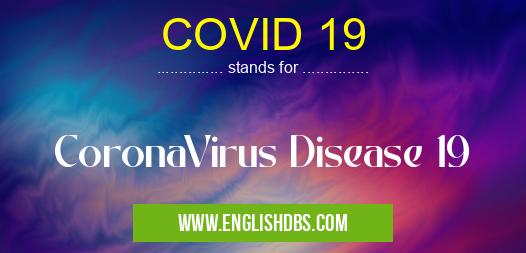What does COVID 19 mean in MEDICAL
COVID is an abbreviation derived from the following words:

COVID 19 meaning in Medical in Medical
COVID 19 mostly used in an acronym Medical in Category Medical that means CoronaVirus Disease 19
Shorthand: COVID 19,
Full Form: CoronaVirus Disease 19
For more information of "CoronaVirus Disease 19", see the section below.
- COVID-19 is an acronym that stands for CoronaVirus Disease 19.
- It is a respiratory illness caused by the SARS-CoV-2 virus, which was first identified in Wuhan, China, in December 2019.
What does COVID-19 Stand for?
- COrona VIrus Disease
Meaning of COVID-19 in MEDICAL
- The acronym COVID-19 specifically refers to the disease caused by the SARS-CoV-2 virus.
- It is a respiratory illness that can range in severity from mild to severe, and in some cases, can be fatal.
Symptoms of COVID-19
- Symptoms of COVID-19 can vary, but the most common include:
- Fever or chills
- Cough
- Shortness of breath or difficulty breathing
- Fatigue
- Body aches
- Headache
- Loss of taste or smell
- Other symptoms can include:
- Nausea or vomiting
- Diarrhea
- Confusion
Essential Questions and Answers on CoronaVirus Disease 19 in "MEDICAL»MEDICAL"
What is COVID-19?
COVID-19 is a disease caused by the novel coronavirus SARS-CoV-2, which first emerged in Wuhan, China in December 2019. It is characterized by symptoms such as fever, cough, shortness of breath, and fatigue.
How does COVID-19 spread?
COVID-19 is primarily transmitted through respiratory droplets produced by infected individuals when they cough, sneeze, or talk. These droplets can enter the mouths or noses of nearby people, or potentially be inhaled into the lungs. Contact with infected surfaces or objects, followed by touching one's own face, can also lead to infection.
Who is at higher risk of severe illness from COVID-19?
Older adults, individuals with underlying medical conditions such as heart disease, lung disease, or diabetes, and immunocompromised individuals are at higher risk of developing severe illness from COVID-19.
What are the symptoms of COVID-19?
Common symptoms of COVID-19 include fever, cough, shortness of breath or difficulty breathing, fatigue, muscle or body aches, headache, new loss of taste or smell, sore throat, congestion or runny nose, nausea or vomiting, and diarrhea. Some individuals may experience mild symptoms, while others may develop severe respiratory illness requiring hospitalization.
How is COVID-19 treated?
Treatment for COVID-19 depends on the severity of the illness. For mild cases, supportive care with rest, fluids, and over-the-counter pain relievers may be sufficient. More severe cases may require hospitalization and additional treatments, such as oxygen therapy, antiviral medications, or corticosteroids.
How can I prevent getting COVID-19?
To reduce your risk of getting COVID-19, follow these preventive measures:
- Get vaccinated and boosted as recommended by health authorities.
- Wear a well-fitting mask in indoor public settings and when in close contact with others.
- Wash your hands frequently with soap and water for at least 20 seconds.
- Avoid touching your eyes, nose, and mouth.
- Stay home if you are sick.
- Get tested if you have symptoms or have been exposed to someone with COVID-19.
- Maintain physical distance of at least 6 feet from people outside your household.
- Clean and disinfect frequently touched surfaces.
Final Words:
- COVID-19 is a serious and contagious respiratory illness caused by the SARS-CoV-2 virus.
- Understanding the meaning and significance of the acronym COVID-19 is crucial for staying informed about the pandemic and taking appropriate measures to prevent its spread.
